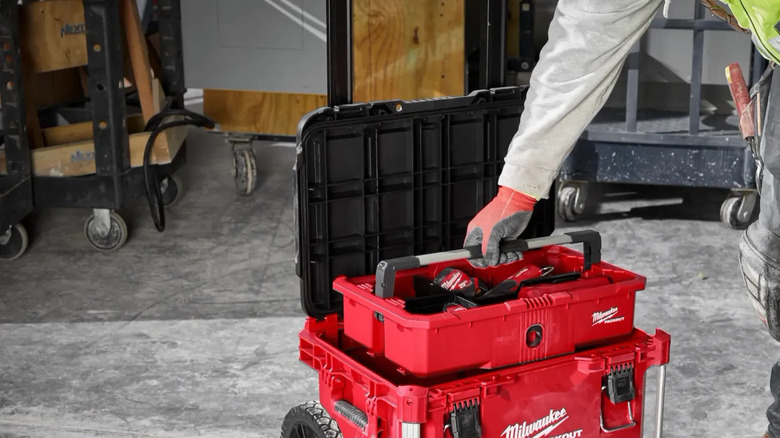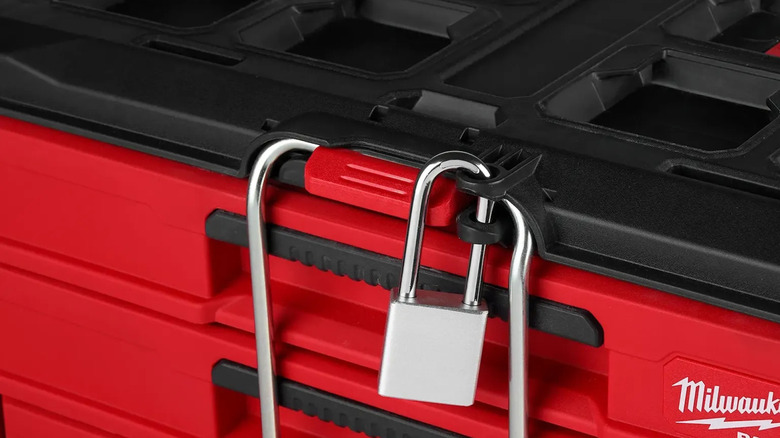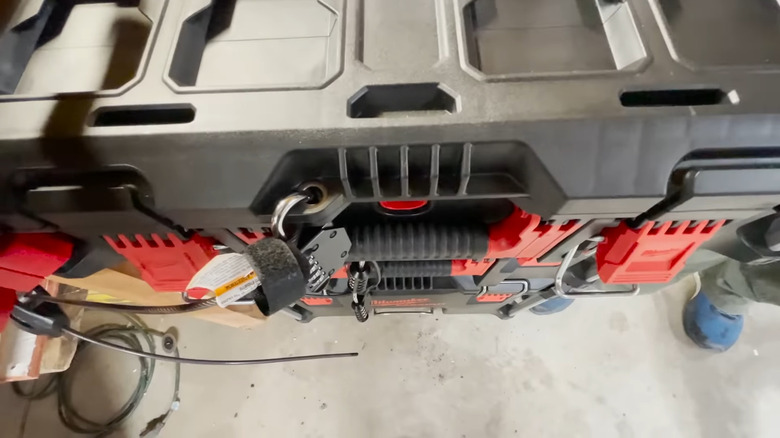What's The Best Way To Lock A Milwaukee Packout?
We may receive a commission on purchases made from links.
Tool theft is, unfortunately, a real problem that both individual workers and jobsite employees put up with. The fact of the matter is that the contents of any given toolbox can be very valuable, and even the toolbox itself could be worth stealing if it's a unique model like a Milwaukee Packout. As with anything else, the best baseline measure to prevent theft is a secure locking mechanism.
All of Milwaukee's Packout toolboxes, including the Rolling Toolbox, 4 Drawer Tool Box, Cabinet, and more, have small circular notches in or near their lids/drawers. The point of these notches is to insert some manner of external locking device, such as a padlock or cable lock. Locking your Packout toolboxes with these kinds of devices is a good place to start, though, according to Milwaukee users on platforms like Reddit and YouTube, it might not always be enough. With a little extra cleverness and ingenuity, you can create a more secure locking setup for your Packout to ensure it can't be taken, opened, or otherwise have its contents pilfered.
Padlocks and cable locks will both fit a Packout lid
The circular notches on a Packout container's lid are just big enough to properly accommodate a typical padlock, one with either a key-operated tumbler lock or a combination lock. Just open the padlock, slide it into the notches, and lock it shut. No one will be able to open the lid of the Packout case until the lock is removed. If you're using a Packout container with drawers instead of a lid, such as the 4 Drawer Tool Box, you'll need to secure the drawers with the security bar first, then install the padlock on the bar's latch at the top. For padlocks, security brand Master Lock makes a cheap and reliable key-locked padlock, which you can get on Amazon.
The only real downside to locking your Packout lids with padlocks is that, if you have a stack of multiple cases, you're going to need individual padlocks for every lid. This can be a little annoying to deal with while you're on the job, which is why another popular choice is a cable lock. By threading a single cable through the circular notches on multiple Packout containers and tightening the locking mechanism, you can bind and lock all of them together at once, then lock them in place with a key. This, in addition to Packout's inherent stack-locking mechanism, will ensure individual boxes can't be taken. Returning to Master Lock, the brand's Python cable lock, also available on Amazon, is a popular choice for this purpose.
Milwaukee users suggest a hybrid locking approach, plus security measures
Padlocks or cable locks should be sufficient to secure Packout containers in the majority of situations. However, as some unfortunate Milwaukee users have testified on Reddit, there are still potential security vulnerabilities. For example, a thief with a sufficiently strong pair of bolt cutters could cut through an individual padlock or cable lock. While the locking point on a Packout container is reinforced with metal, the majority of the lid is just plastic. With enough force and jimmying, a thief could rip the lid open, even if it's padlocked.
This is why some users opt for a hybrid approach, incorporating several lock types at once alongside certain other strategies. YouTube channel JakeofALL suggests attaching individual padlocks to every lid in a Packout stack, then snaking a cable lock through those padlocks and securing it to a sturdy, solid point like the leg of a heavy workbench. Firmly securing the entire stack will make it more difficult for a would-be thief to jimmy the lid or run away with the whole thing. If you're concerned about bolt cutters, YouTube channel Addicted to Tools suggests threading some nuts onto your padlock both to reinforce it and make it harder for cutters to find purchase.
If you're still worried, Reddit users suggest taking additional personal security measures, such as attaching tracking tags like a Milwaukee Tick, using tools with Milwaukee's One-Key system, and, if you're permitted, taking your tools home with you at the end of the work day.


